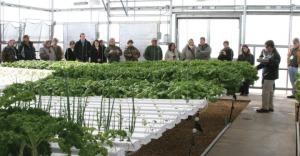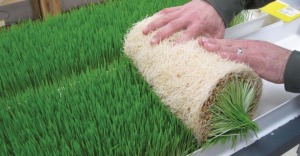Grass fodder is used as an animal feed and can be produced in great numbers within 8 days from seed to grass for all livestock & even quicker with Co2 added. Various varieties of grass fodder include, but are not limited to, barley, oat grass, lucerne grass, rye grass or whatever grass one wishes to grow in ones country.For more you can visit http://alfaculture.com
Thursday 12 February 2015
Monday 9 February 2015
Indoor Gardening Tips for Winter
Just because the winter is around the corner, it does not mean that you need to throw away your gardening gloves and kill time until spring to get your hands soiled again. People often ignore the fact that during the winter, their home offers an ideal atmosphere for plants to flourish and they can cultivate most of the fresh greens & veggies that they’d produce throughout the warmer seasons. Here in this post, we’ll discuss about few winter gardening ideas to make your indoor gardening experience a massive success:
 • Arrange adequate light – as winter takes over, the hours of sunshine sometimes look to completely disappear. Productive and cost-effective lighting is possibly the biggest difficulty people encounter as indoor gardeners. Though a sunny window may be sufficient to keep few herbs or small plants progressing, to make the most your indoor gardening space, you will wish to incorporate supplemental light. There are many artificial lights available online that you can use for your indoor gardening.
• Arrange adequate light – as winter takes over, the hours of sunshine sometimes look to completely disappear. Productive and cost-effective lighting is possibly the biggest difficulty people encounter as indoor gardeners. Though a sunny window may be sufficient to keep few herbs or small plants progressing, to make the most your indoor gardening space, you will wish to incorporate supplemental light. There are many artificial lights available online that you can use for your indoor gardening.
• Develop a clean working area – it can be really messy when you work with soil indoor. To assist keep soil getting all over the place you should put a dirt-free trap down prior to you do any work. This way you’ll not concerned about spilling dirt and it makes blending soil mixtures, transplanting and filling containers much more pleasurable indoors.
• Keep a stable temperature – many plants that you consume are very responsive to temperature changes. For example, Basil is especially responsive to the cold, thus, a draughty area close to an exterior outdoor wouldn’t be ideal.
• Appropriate ventilation – plant requires a decent flow of air to grow ideally. Putting a fan close to your plants indoor will make sure that they’re getting a steady flow of air. Maintaining a constant flow of air not just helps harden your plant but also keep insects at bay.
 • Appropriate humidity – maintaining a proper humidity level is very essential, but often ignored by gardeners. One great way to maintain the humidity level for your indoor garden is by positioning a cool mist humidifier beside your garden.
• Appropriate humidity – maintaining a proper humidity level is very essential, but often ignored by gardeners. One great way to maintain the humidity level for your indoor garden is by positioning a cool mist humidifier beside your garden.
• Inspect properly and often – indoor gardening does have its negative side. Maintaining a clean working area and making use of products designed for indoor use help wonderfully to keep your garden pest free. Early detection and appropriate treatment will stop bugs from spreading to other parts of your indoor garden.
Wednesday 4 February 2015
Employ Rockwool in Hydroponic Gardening
Rockwool is an adaptable growing medium that can be utilized as a separate product or in a range of hydroponic systems. In this article, we’ll guide you through the essential procedure of how to employ rockwool as a part of hydroponic farming.
• Buying the product – buy a packet of 1 rockwool cubes for seed circulation. These are normally sold in suitable packs that fit ideally into a regular 10” x 20” plastic dish.
• Fine-tuning the pH level – relying on the brand of rockwool you buy, the subsequent instructions may differ. Fine-tune the pH level of the water to 5.5 employing lemon water if you’ve that on hand. Check and adjust the pH level as required employing a pH kit. Drench the rockwool until the medium is immersed completely. Don’t compress the back since the substance has been intended for an ideal air/water proportion for agriculture purposes.
• Planting the seeds – plant seeds in all cubes. Relying upon the seed, you may wish to plant numerous seeds in every cube.
• Including the nutrient solution – use a watery nutrient solution to water your plants. Throughout the primary stages of the plants’ growth cycle, the plants won’t require the complete supply of macronutrients supplied by the supplement solution. The quality of the supplement solution can improve as the plants grow into complete maturity.
• Transplanting into a fresh medium – the rockwool cubes are prepared to be transplanted as soon as the taproot is noticeable at the base of the cube. Right now, you’ll wish to figure out where you’d like to move your plant, whether it is a bigger rockwool block, a pot with loose stuff or a hydroponic system. Despite the fact, ensure the fresh media is pre-soaked with supplement solution or ideally running before transplantation to decrease the danger of transplanting blow.
 Be watchful while transferring rockwool to a soilless medium in light of the fact that the new medium can soak away water and dried up the rockwool block prior to the roots achieves the new soilless media. Accordingly, it’s vital for the plants’ root system to be settled prior to transplanting.
Be watchful while transferring rockwool to a soilless medium in light of the fact that the new medium can soak away water and dried up the rockwool block prior to the roots achieves the new soilless media. Accordingly, it’s vital for the plants’ root system to be settled prior to transplanting.
Rockwool is a great alternative for soilless substance for both commercial farmers and hobby gardeners.
So, don’t be too lazy! Employ these strategies to enjoy hydroponic gardening all through the year.
Subscribe to:
Posts (Atom)
